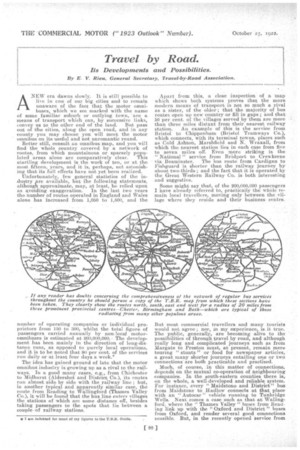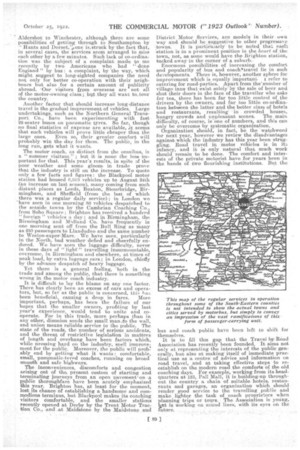Travel by Road.
Page 18

Page 19

If you've noticed an error in this article please click here to report it so we can fix it.
Its Developments and Possibilities.
By E. V. Rieu, General Secretary, Travel-by-Road Association.
ANEW era dawns slowly. II is still possible to live in ens of our big cities and to remain unaware of the fact that the motor omnibuses, which we see ina,rked with the name of some familiar suburb or outlying town, 'are a means of transport which can, by successive links, convey us to the other end of the land. But pass out of the cities, along the open road, and in any county you may choose you will meet the motor omnibus on its useful and not unromantic round.
Better still, consult an omnibus map, and you will findthe whole country covered by a network of routes, from which mountainous or sparsely pcvu lated areas alone 'are comparatively clear. This startling development is the work of ten, or at the most fifteen, years, and it is, perhaps, not astonishing that its full effects have not yet been realized.
Unfortunately, few general statistics of the industry pare available, but the following statements, although approximate, may, at least, he relied upon as avoiding exaggeration. In the last two years the number of routes operated in England and Wales alone has increased from 1,050 to 1,800, and the
number of operating companies or individual proprietors from 150 to 300, whilst the total figure of passengers carried annually by non-local motoromnibuses is estimated at 200,000,000. The development has been mainly in the direction of long-distance runs, as opposed to purely local operations, and it is to be noted that 90 per cent. of the services run daily or at least four days a week.*
The idea. has gained ground of late that the motor omnibus industry is growing up as a rival to the railways. " In a good many. cases, e.g.„ from Chichester to Midhurst (Aldershot and District Co.), its routes run almost side by side with the railway ; but, in another typical and apparently similar ease, the route from Reading to Wallingford (Thames Valley Co.), it will be found that the bus line enters villages the stations of which are some distance off, besides taking passengers to the spots that lie between a couple of railway stations.
Apart from this, a close inspection of a map which shows both systems proves that the more modern means of transport is not so much a rival as a sister, of the older; that the majority of bus routes open up new country or fill in gaps ; and that 30 per cent, of the villages served by t•heni are more than three miles distant from their nearest railway station. An example of this is the service from Bristol to Chippenham (Bristol Tramways Co.), which connects, with its terminal towns, places such as Cold Ashton, Marshfield and N. Wraxall, from which the nearest station lies in each case from five to seven miles off. Even more striking is the " National " service from Bridport to Crewkerne via Beaminster. The bus route from Cardigan to Fisbguard is shorter than the railway journey by about two-thirds ; and the fact that it is operated by the Great Western Railway Co. is both interesting and suggestive.
Some might say that, of the 200,000,000 passengers I have already referred to, practically the whole remain local travellers, moving only between the .villags where they reside and their business centre.
But most commercial travellers and many tourists would not agree ; nor, in my experience, is it true. The public, generally, are becoming alive to the possibilities of through travel by road, and although really long and camplicated journeys such as from Margate to Preston must, at present, remain mere touring " stunts" or food for newspaper articles, • a great many shorter journeys entailing one or two connections" are both practicable and practised.
Much, of course, in this matter of connections, depends on the mutual co-operation of neighbouring companies. In the south-eastern counties there is, on the whole, a well-developed and reliable system. For instance, every " Maidstone and District" bus from Maidstone to Hadlow connects at that place with an "Autocar " vehicle running to Tunbridge Wells. Next comes a case such as that at Wallingford; where the " Thames Valley " buses from Reading link up with the " Oxford and District" buses from Oxford, and render several good connections possible. .But, in the recently opened service from Aldershot to 'Winchester, although there am some possibilities of getting through to Southampton by ' Rants and Dorset,"eone is struck by the fact that, in several cases, the services seem arranged to miss each other by a few minutes. Such lack of co-ordination was the subject of a complaint ,made to me recently by two Americans who had " dene England" by bus : a complaint, by the way, which might suggesV to long-sighted companies the need not only for better co-operation with their neighbours but also for a certain amount of publicity abroad. Our visitors from overseas are not all of the motor-owning class; lint Ahey all want to_tour the country.
Another factor that should increase long-distance travel is the gradual improvement of vehicles. Large undertakings, such as the Northern General Transport, Co., have been experimenting with fast 22-seater buses on pneumatic tyres. So far„. though no final statistics of expense are available, at seems that such vehicles will prove little cheaper than the
large ones. Even so, their greater comfort will probably win the day for them. The public, in the long run, gets what it wants.
The motor coach., as distinct from the omnibus, is a " summer visitant" ; but it is none the lessimportant for that. This year's results, in spite af the poor weather and some gloom in trade prove that the industry is still on the increase. To quote only a few fact's and figures: the Blackpool motor Station had housed 0,010 vehicles up to August 2,4th (an increase on last season), many coming from such distant places as Leeds, Buxton, Stourbridge, Birmingham, and Sheffield (from the last of which. there was a regular daily service); in London we have seen in one morning 80 vehicles despatched to the seaside towns by the Cambrian Coaching Co., from Soho Square ; Brighton has received a hundred 'foreign " vehicles a day ; and in Birmingham, the Birmingham and Midland Co. have frequently in one morning sent off from the Bull Rink as many as 2-50 passengerato Llandudno and the same number to Weston-super-Mare. We have seen, particularly in the North, bad weather defied and cheerfully endured. We have seen the luggage difficulty, never in these days of " light" travelling insurmountable, overcome, in Birmingham and elsewhere, at times of peak load, by extra luggage cars; in London, chiefly by the advance despatch of heavy luggage.
Yet there is a general feeling, 'both in the trade and among the public, that there is something wrong in the motor coach industry. . It is difficult to lay the blame on any one factor. There has clearly been an excess of cars and operators, but, so far as the public is concerned, thiq has
been beneficial, causing a drop in fares. More important, perhaps, has been the failure of our hopes that the smaller owners, profiting by last year's experience, would tend to unite and cooperate. For in this trade, more perhaps than in any other, disunion sends the small man to the wall, and union means reliable service to the public. The state of the roads, the number of serious accidents, and the threat of restrictive legislation in matters of length and overhang have been factora which, while nressing hard on the industry, spell improvement for the public. Moreover, the public will probably end by getting what it wants: comfortable, small, pneumatic-tvred coaches, running on broad smooth and safe high-ways.
The inconveniences, discomforts and congestion arising out of the, present custom of starting and terminating journeys from an open pavement on -a public thoroughfare have been acutely emphasized this year. Brighton has, at least for the moment, lost its chance of establishing a handsome and com
modious terminus, but Blackpool makes its coaching visitors 6orrifortable, and the smaller stations recently opened at Der by the Trent Motor Traction. Co., and at Mai tone by the Maidston.e and District Motor Services, are models in their own way andshould be suggestive to other progreasiva !towns. It is partiiiitiarly. to be noted tbaa each station is in a prominent position in the heart of the, town, not, as some would have the Brighton station, tucked away-in the corner of a suburb. Enormous possibilities of increasing the comfort and popularity of bus and coach6travei lie in such developments. There is, however, another sphere for improvement which is equally important. i refer to catering for road-parties. Apart from thenumber of village inns that exist solely by the sale of beer and shut their doors in the face of the traveller who asks for tea, there has been far too lit-tie control of the drivers by the owners, and far too little co-ordination between the latter and the better class of hotels and restaurants, resulting: in crowded houses, hungry crowds and unpleasant scenes. The main difficulty, of course, is-one of numbers., and this can only be overcome by systematic organization.
Organization should, in fact, be the wateliword for next year, however we review the disadvantages against which the industry has this year been struggling. Road travel in motor vehicles is in its infancy, and it is only natural that much work should remain to be done. The comfort and interests of the private motorist have for years been in the hands of 'two flourishing institutions. But the bus and coach public have been left to shift for themselves.
it is to fill this gap that the Travel by-Road Association has recently been founded. It aims not only at representing the interests of the public generally, but also at making itself of immediate practical use as a centre of advice and information on road travel, and at taking effective steps to reestablish on the modern road the comforts of the old coaching days. For example working from its headquarters at 123, Pall Mall, a is building-up throughout the country, a chain -of suitable hotels, restaurants and garages, an organization which should render good service to the travelling public and make lighter the task of coach proprietors when planning trips or tours. The Association is young, }at is working on sound lines, with its eyes on the future.






















































